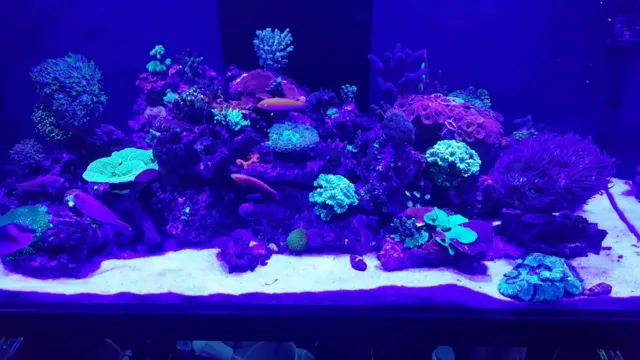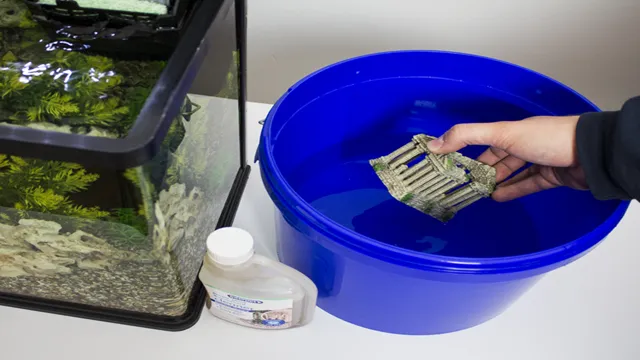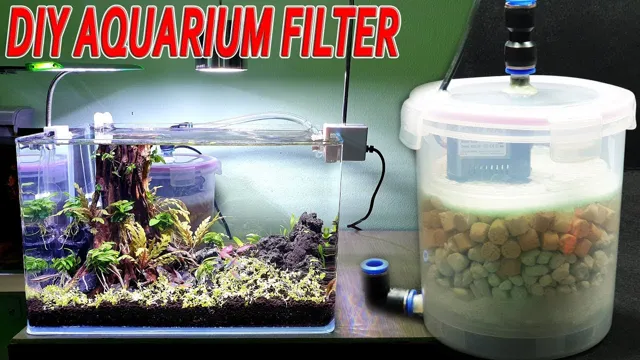As a reef aquarium enthusiast, you want to ensure the safety and health of your marine life. Phosphate levels in your aquarium water, if left unchecked, can negatively impact the wellbeing of your corals, fish, and other inhabitants. Phosphates are essentially a food source for algae, and if their levels are high, this can lead to an unwanted algal bloom that can rob your corals of vital nutrients, ultimately harming their growth and vibrancy.
Lowering phosphate levels can seem challenging, but with the right strategies and techniques, it’s entirely achievable. In this blog, we’ll explore some of the best ways to lower phosphates in reef aquariums and ensure your marine life thrives.
Understanding Phosphates
Are you struggling to maintain a healthy balance of phosphate in your reef aquarium? Phosphate is an essential element in the growth of algae and can quickly become a nuisance by causing excessive algae growth. One of the most effective ways to lower phosphate levels is by performing regular water changes and utilizing phosphate removing media in your filtration system. You can also limit the amount of food given to your aquatic pets as uneaten food quickly decomposes and releases phosphates.
Additionally, it’s essential to ensure that your aquarium’s substrate is regularly cleaned to prevent the buildup of detritus, which ultimately leads to an increase in phosphates. By taking these preventative measures, you can maintain ideal phosphate levels in your reef aquarium and enjoy a thriving aquatic community.
Sources of Phosphates in Aquariums
Phosphates are a common problem in aquariums that can lead to poor water quality and health issues for fish and other aquatic life. Understanding where phosphates come from can help you prevent their buildup in your aquarium. Phosphates can enter an aquarium through a variety of sources, including fish food, decaying plant matter, tap water, and even aquarium equipment like filters and rocks.
Overfeeding your fish can also contribute to excess phosphate buildup, so it’s important to feed them only the amount they need. Regular water changes and cleaning of equipment can help reduce phosphate levels in your aquarium. By taking steps to control phosphate levels, you can help ensure a healthy and thriving aquatic environment for your fish and other aquatic life.

Reasons to Lower Phosphates
Phosphates are chemical compounds that contain phosphorous, and they occur naturally in many different forms. However, excess phosphates in our water systems can cause a range of problems, including environmental damage, algal blooms, and reduced water quality. That’s why it’s important to understand the sources of phosphates, how they enter our waterways, and what we can do to reduce them.
Some common sources of phosphates include fertilizers, detergents, and sewage. These compounds can enter rivers, lakes, and other bodies of water through runoff, leaks, and other means. To help reduce phosphate levels, it’s important to be mindful of the products we use and to take steps to prevent runoff from entering our waterways.
By conserving water, reducing our use of fertilizers and other phosphorus-heavy products, and reducing our impact on the environment, we can help protect our natural resources and reduce the negative effects of excess phosphates.
Measuring Phosphate Levels
If you’re struggling with high phosphate levels in your reef aquarium, there are several steps you can take to lower them. One of the first things you should do is measure your current phosphate levels so that you have a baseline to work from. This can be done using simple test kits that are readily available at most pet stores.
Once you have your initial reading, you can then start implementing strategies to reduce the amount of phosphate in your tank. Some effective methods include increasing water flow, using phosphate-removing media or chemicals, and reducing the amount of food you’re feeding your fish and other creatures. Another key factor to consider is making sure your tank is properly maintained, including routine water changes and regular cleaning of any equipment.
By taking these steps and monitoring your phosphate levels over time, you can help create a healthier environment for your aquatic pets and ensure the long-term success of your reef aquarium.
Types of Phosphate Tests
When it comes to measuring phosphate levels, there are a few different tests that can be utilized. One common method is the orthophosphate test, which measures the concentration of orthophosphate ions in a sample. Another option is the total phosphate test, which looks at all forms of phosphate present in the sample. (See Also: How to Make an Aquarium out of Old Tv: Transform Your Vintage Set into a Stunning Tank)
Additionally, the reactive phosphate test can be used to determine the amount of phosphate that is available to organisms for use. These tests can be helpful in a variety of settings, from monitoring water quality to checking the nutrient levels in soil for agriculture. So, whether you are a scientist, farmer, or someone interested in maintaining a healthy environment, understanding these phosphate tests can be useful.
By utilizing them appropriately, you can help ensure that phosphate levels are at suitable levels for the particular situation.
Recommended Phosphate Levels
As an aquarium owner, measuring the phosphate levels in your tank is essential to maintaining a healthy environment for your fish and other aquatic animals. Phosphates are a naturally occurring compound and are crucial to the growth of algae, which is why high levels can lead to an overgrowth of algae that can harm your tank’s inhabitants. Ideally, your phosphate levels should be between 0.
03 and 0.1 parts per million (ppm). You can measure your tank’s phosphate levels using a phosphate test kit, which is readily available at pet stores or online.
It’s essential to follow the instructions carefully when using a test kit to ensure accurate readings. If your phosphate levels are too high, you can reduce them by conducting regular water changes and using phosphate-removing media. By keeping an eye on your phosphate levels, you can maintain a balanced and healthy aquarium for your aquatic pets to thrive.
Ways to Lower Phosphates in Reef Aquariums
For reef keepers, high phosphate levels in their aquariums can lead to a host of problems, such as algae blooms, stunted growth in coral, and a compromised ecosystem. To prevent these issues, it’s important to regularly test the water and maintain a low level of phosphates. One simple way to lower phosphates is by feeding your fish and invertebrates less; uneaten food can lead to excess nutrients in the water.
Another effective method is to use a protein skimmer, which removes organic waste before it can break down into phosphates. Additionally, a phosphate-reducing media (such as GFO) can be added to your filter system to continuously remove phosphates from the water. By implementing these strategies, you can help keep your reef aquarium clean, healthy, and thriving.
Reducing Feedings
Reducing feedings is one of the most effective ways to lower phosphates in reef aquariums. These tiny creatures need food to survive, but feeding them too much can lead to an increase in phosphates, which can harm the delicate balance of the ecosystem. One way to reduce feeding is to give smaller portions and not overfeed.
Another solution is to feed less frequently. Many hobbyists have found that feeding once per day or every other day works best for their reef aquarium. It’s essential to pay attention to the behavior of the fish and the overall health of the reef to ensure that they are getting enough to eat and not starving.
Careful consideration should always be given to the types of food being offered, and how different creatures in the aquarium will react to the nutrients in each type of food. By taking these steps to limit feeding and controlling the amount of waste generated, the phosphate levels in the reef aquarium can be kept under control, creating a healthier environment for the creatures that call it home.
Quality Feeding Practices
If you’re looking to lower phosphates in your reef aquarium, quality feeding practices are key. One way to achieve this is to avoid overfeeding your fish. Uneaten food can break down into phosphates and other harmful substances that will raise your aquarium’s phosphate levels. (See Also: How to Propagate Freshwater Aquarium Plants: Tips and Techniques)
Consider feeding your fish smaller portions more frequently throughout the day instead of one large meal. Another way to lower phosphates is to feed your fish high-quality, natural foods. Processed or artificial foods can contain additives and preservatives that also contribute to high phosphate levels.
Opt for fresh or frozen foods that are more natural to keep your aquarium healthy. Lastly, make sure to clean your aquarium regularly to remove any excess food or debris that may contribute to high phosphate levels. By following these simple practices, you can promote a healthy, balanced aquarium environment for your reef inhabitants.
Use of Skimmers and Filtration Systems
Phosphates in reef aquariums One effective way to lower phosphates in reef aquariums is through the use of skimmers and filtration systems. Skimmers work by collecting organic waste and debris from the water column, which can contribute to the buildup of phosphates. Filtration systems, such as activated carbon and phosphate removers, can also be added to help remove phosphates from the water.
It’s important to regularly clean and maintain these systems to ensure their effectiveness. Additionally, minimizing overfeeding and adding only high-quality, low-phosphate foods can also help reduce phosphate levels in the aquarium. By taking these steps, reef aquarium enthusiasts can maintain a healthy environment for their marine life.
Water Changes and Phosphate Removal Media
One of the most important things to consider when running a successful reef aquarium is maintaining appropriate nutrient levels, including phosphates. High levels of phosphates in aquarium water can lead to the growth of pesky algae and even harm your coral. One effective way to reduce phosphates in your tank is through regular water changes, which can help to dilute any excess nutrients.
Another option is to make use of phosphate removal media, such as specialized filters or chemical additives, which actively bind and remove excess phosphates present in the water. By incorporating these methods into your aquarium maintenance routine, you can help keep your water clean and healthy for your aquatic inhabitants.
Maintaining Low Phosphate Levels
If you’re a reef aquarium owner, then you know how critical it is to maintain low levels of phosphates. Phosphates are the primary source of excess nutrients in the water, and high levels can lead to numerous issues such as algae growth, poor coral health, and even fish death. So how do you lower phosphates in your reef tank? One effective way is to use a specialized resin or media that can bind and remove phosphates from the water.
You should also implement good feeding practices, minimize overfeeding, and ensure that your filtration system is adequately equipped to handle the bioload of your tank. Furthermore, you should conduct regular water changes and test your water chemistry regularly to detect any abnormal spikes in phosphate levels. Remember, maintaining low levels of phosphates is crucial for ensuring a healthy and thriving reef aquarium.
Regular Testing and Monitoring
Regular testing and monitoring is crucial in maintaining low phosphate levels in your aquarium. Phosphates are harmful to your aquatic life as they promote the growth of algae, which can deplete oxygen levels and lead to the death of your fish and other organisms. To prevent this, it’s recommended to test for phosphates regularly and keep them at a low level.
You can do this by using a test kit to monitor the phosphate levels in your aquarium water and then taking steps to reduce it if the levels are too high. One way to do this is by performing regular water changes, using high-quality filtration systems, and limiting the amount of fish food and other organic matter that enters the aquarium. By keeping a close eye on your phosphate levels, you can ensure that your aquarium remains healthy and your aquatic life thrives.
Proper Aquarium Maintenance
Maintaining low phosphate levels in your aquarium is crucial for keeping your aquatic pets healthy and your tank looking beautiful. High phosphate levels can cause excessive algae growth, which in turn can consume oxygen and create a lack of oxygen for your fish and other aquatic creatures. One effective way to maintain low phosphate levels is by regularly cleaning your aquarium and its filtration system.
You can also use special phosphate-removing products, such as activated carbon or phosphate-removing chemicals, to reduce the amount of phosphate in the water. Another tip is to avoid overfeeding your fish as excess food can contribute to high phosphate levels. By implementing these strategies, you can help keep your aquarium in top condition, allowing your aquatic pets to thrive and flourish. (See Also: How to Get to Sydney Aquarium: A Stress-Free Guide for Tourists)
Conclusion
In conclusion, reducing phosphates in a reef aquarium is crucial for maintaining the health and vitality of your coral and fish. By employing a combination of techniques such as regular water changes, using specialized phosphate removing media, and being mindful of overfeeding and excess waste, you can keep your phosphates in check and create a thriving underwater ecosystem. Remember, when it comes to phosphates, less is definitely more!”
FAQs
What are phosphates and why are they a concern in a reef aquarium?
Phosphates are a type of nutrient that can fuel algae growth and harm coral in a reef aquarium. It is important to keep phosphates at low levels to maintain a healthy ecosystem.
What are some sources of phosphates in a reef aquarium?
Phosphates can be introduced into a reef aquarium through fish waste, overfeeding, decaying organic matter, tap water, and certain aquarium products.
How can I test for phosphates in my reef aquarium?
There are phosphate test kits available for purchase at most aquarium supply stores. Follow the instructions carefully to get an accurate reading.
What are some ways to lower phosphates in my reef aquarium?
Some methods to lower phosphates include performing regular water changes, using a protein skimmer, adding macroalgae, reducing feeding and overstocking, and using phosphate-removing media.
How long does it take to lower phosphates in a reef aquarium?
It can take several weeks to see a significant decrease in the phosphate levels in a reef aquarium. Consistent monitoring and maintenance is crucial.
Can high phosphates have a negative impact on fish in my reef aquarium?
High phosphates can contribute to poor water quality, which can harm fish and other inhabitants in the aquarium.
Is it possible to have phosphates too low in a reef aquarium?
Yes, having phosphates too low can also be harmful to coral and other inhabitants in the aquarium. It is important to maintain a healthy balance of nutrients.






